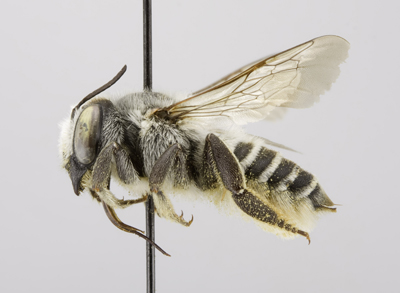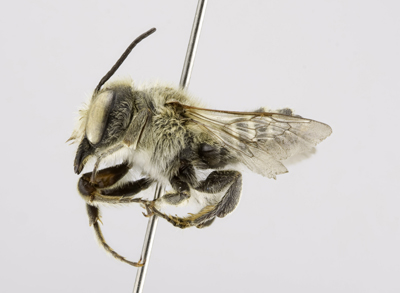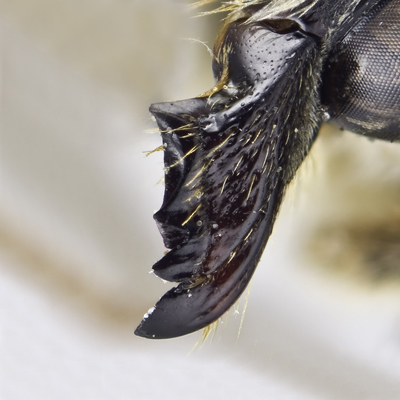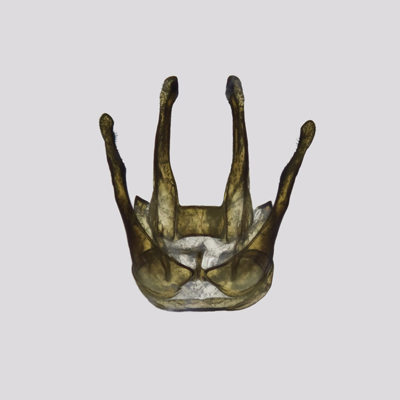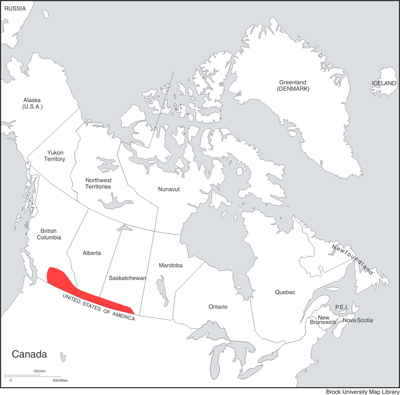
1. Megachile (Argyropile) parallela Smith, 1853
Megachile parallela Female |
Megachile parallela Male |
Megachile parallela Smith, 1853. Cat. Hym. Brit. Mus. 1: 191 (♂).
Megachile facunda Cresson, 1872. Trans. Amer. Entomol. Soc. 4: 266 (♂).
Megachile sexdentata Robertson, 1895. Trans. Amer. Entomol. Soc. 22: 125 (♂).
Megachile verbesinae Cockerell, 1908a. Ann. Mag. Nat. Hist. (8) 1: 264 (♀).
Megachile (Argyropile) parallela var. rita Mitchell, 1937a. Trans. Amer. Entomol. Soc. 63: 53 (♀).
Megachile parallela tulariana Mitchell, 1937a. Trans. Amer. Entomol. Soc. 63: 53 (♀).
Megachile (Argyropile) asterae Mitchell, 1943. Pan-Pacific Entomol. 19: 13 (♀).
Megachile (Argyropile) parallela reta Mitchell, 1943. Pan-Pacific Entomol. 19: 16 (♀) (misspelling of M. parallela rita).
Diagnosis.The female of M. parallela is distinct, and can be recognized by apex of S6, which has a bare, slightly upturned rim projecting slightly beyond the dense fringe of short, dark hairs. The male of M. parallela is recognized by the combination of 4-dentate mandibles, unmodified front legs, two pairs of prominent teeth on the apical margin of T6 (below the carina), and the absence of red bristles on the front coxa. They are most similar to M. addenda. The male of M. addenda lacks the two pairs of prominent teeth on the apical margin of T6, and has red bristles on the front coxa.
FEMALE: Length 13-14 mm.
Head:
Figure M1: Megachile parallela female mandible |
1) compound eyes slightly convergent below; distance from lateral ocelli to compound eyes subequal to distance to vertex, 2) clypeal margin straight, with a rather narrow, slightly produced, median area that is shiny and impunctate, with very small but distinct median tubercle, 3) mandibles 4-dentate, with long cutting edge between 3rd and 4th teeth and much shorter one between 2nd and 3rd teeth (Figure M1), 4) gena subequal to compound eye in width, 5) punctures deep and distinct, but quite fine and close on vertex and gena, face below ocelli finely and densely punctate beneath dense pubescence, on supraclypeal area and clypeus deep, distinct, quite close, with shining interspaces especially medially on clypeus, 6) pubescence white, rather short but dense on face below level of median ocellus, sparse on clypeus and supraclypeal area, with median sparse white patch between lateral ocellus and vertex, dense and white on gena, somewhat more elongate below, vertex with scattered short black pubescence laterally, 7) F1 longer than broad (3:2) and longer than pedicel, which is quadrate, subequal in length to remaining flagellomeres.
Mesosoma:
1) pubescence pale and quite dense laterally and posteriorly, though not obscuring the surface of mesoscutum, entirely pale on scutellum, 2) mesoscutum dull, punctures very fine and quite close, more so laterally, slightly separated medially, surface tessellate; scutellum and axilla very densely and finely punctate; pleura finely and closely punctate, somewhat more coarsely below, becoming fine and densely crowded above; propodeum smooth but dull, with minute and rather vague punctures separated by interspaces of 1-2 pd, triangle dull and impunctate, 3) front tarsus slender; mid basitarsus broad apically, anterior apical margin narrowly produced; tarsomeres 2 and 3 very narrow at base, dilated apically, with the anterior apical angle slender and produced; hind basitarsus long and broad, subequal to hind tibia, and nearly equaling it in length, spurs pale yellow, 4) tegula somewhat shining, very minutely and closely punctate throughout, 5) wings subhyaline, faintly clouded apically, veins brownish-black.
Metasoma:
1) T2 and T3 distinctly and narrowly grooved across base, basal margin of groove distinct but not carinate, T4 faintly impressed toward base, more conspicuously so laterally, basal margin not distinct; T1-T5 with apical margins narrowly depressed, densely pale fasciate; T1 with copious, elongate, entirely pale yellowish/whitish pubescence, T2 with discal pubescence very short and dense, black laterally, somewhat longer and pale at centre of disc, T3-T5 with pubescence entirely black, very short, and quite dense; punctures of terga fine and very close throughout, becoming densely crowded laterally on more basal terga, somewhat deeper and more distinct apically; T6 nearly straight in profile, with few short, suberect hairs, apical half densely pale tomentose, surface very finely and densely punctate, 2) S6 narrowly rounded at tip, with short, black scopal hairs, sparse apically, the apex with bare, slightly upturned lip projecting slightly beyond the dense fringe of short, dark hairs; scopa otherwise white, punctures slightly separated and fine on more basal sterna, coarser apically.
MALE: Length 12-13 mm.
Head:
1) compound eyes slightly convergent below; lateral ocelli somewhat closer to eyes than margin of vertex (4:4.5), 2) apical margin of clypeus beneath pubescence with a rather narrow, slightly produced impunctate area that is emarginate medially with a rather small but distinct median tubercle, 3) mandibles obscurely 4-dentate, lower process very narrow, quite elongate, subbasal in position 4) gena subequal to compound eye in width, 5) punctures deep and distinct, fine and close on vertex and gena adjacent to eye margin, more widely separated along posterior margin; face below ocelli and clypeal surface very finely and closely punctate beneath the pubescence, 6) pubescence largely pale, copious and dense on face below ocelli and on clypeus, creamy to snowy white, often somewhat more yellowish and less dense on vertex and gena, becoming longer on gena below, 7) F1 slightly longer than broad (5:4), longer than pedicel, but slightly shorter than remaining flagellomeres, which are longer than broad (3:2), apical flagellomere more elongate (4.5:2).
Mesosoma:
1) pubescence dense and pale laterally and posteriorly, though not concealing surface beneath, mesoscutum and scutellum with shorter and somewhat more sparse, erect, yellowish-white hairs, 2) mesoscutum dull, very densely tessellate, punctures minute and obscure; scutellum distinctly punctate, punctures minute, densely crowded; pleura with fine, close punctures below, densely crowded above; propodeum somewhat shining, minutely punctate with interspaces >1 pd, triangle dull, impunctate, 3) front coxal spine small, slender, acute, largely obscured by white pubescence; all basitarsi slender and simple, front tarsus elongate and slender, with short but dense, posterior, white fringe; mid tibial spur short but well developed, 4) tegula shiny, minutely and closely punctate anteriorly, punctures more sparse posteriorly, 5) wings subhyaline, faintly clouded apically, veins brownish-black.
Metasoma:
1) T2-T5 depressed basally, basal margins distinct but not definitely carinate, apical margins of terga deeply depressed at least laterally, more deeply and completely on the more apical terga, densely pale fasciate, T1 and T2 with discal pubescence entirely yellowish-white, copious, long and erect, T3-T5 with pubescence sparse, very short, erect; T4 and T5 with transverse, basal, tomentose fasciae, quite broad on T5; T1 and T2 with punctures minute, densely crowded, becoming somewhat more distinct and coarse but still close on T3-T5, slightly separated and elongate toward apical margin of T5; basal area of T6 smooth,impunctate with distinct carinate rim, area apical to this densely tomentose, obscuring the surface, very minutely and closely punctate, apical carina rounded, margins faintly crenulate, with deep semicircular median emargination, slightly impressed medially just before the emargination, median teeth of apical margin erect, conspicuous, rather narrowly carinate, tips subtruncate, much closer to the more acute, lateral teeth than to each other; T7 narrowly produced medially, tip very slightly incised, 2) S1-S4 exposed, S2-S4 shining, very finely and closely punctate basally, less so on apical terga, S2-S4 deeply grooved basally, apical margins strongly depressed, rims narrowly yellowish-hyaline, fringed with long, pale hairs forming thin apical fringe, discs of sterna with sparse pale pubescence.
Genitalia: Figure G1.
|
Figure G1: Megachile parallela genitalia |
Discussion:
Relatively common in western Canada, especially in mixed prairie regions (Hobbs and Lilly (1954). This species is a ground nester (Table 1). Gonzalez and Griswold (2007) recently revised the subgenus Argyropile.
Distribution:
This species occurs from southern SK to BC (see Map 1).
|
Map 1: Canadian distribution of Megachile parallela |
